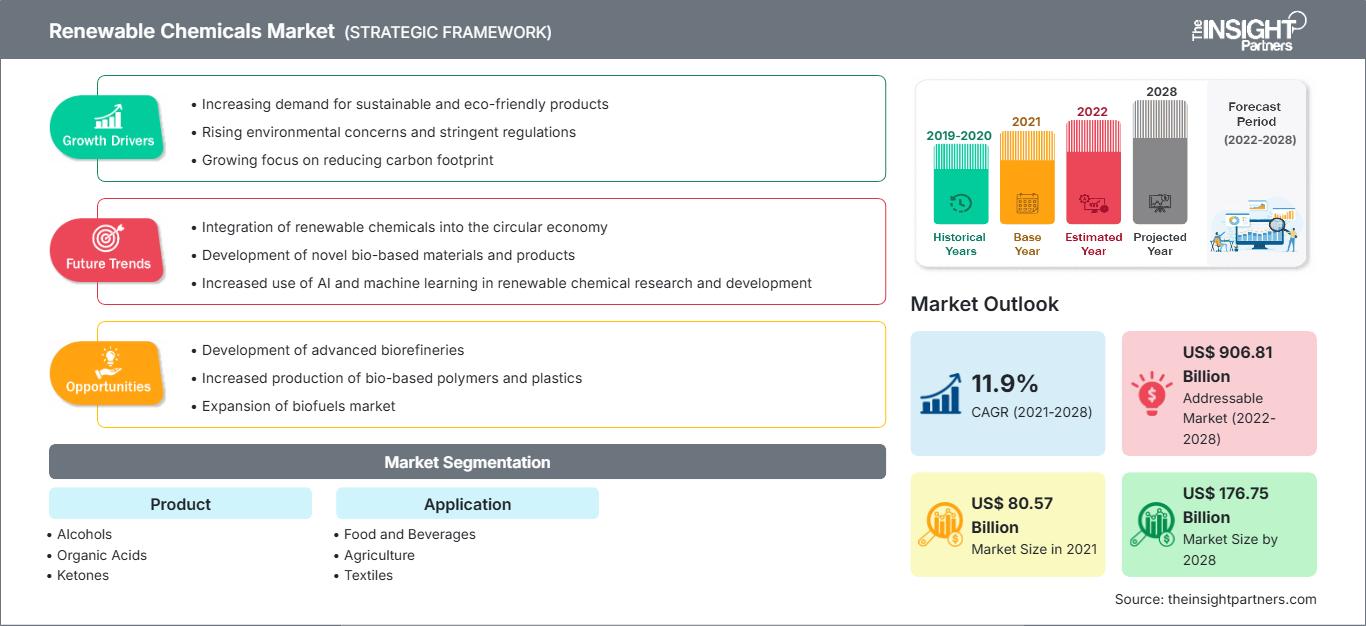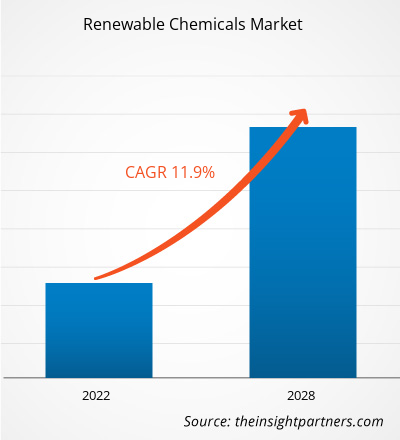Der Markt für erneuerbare Chemikalien wurde im Jahr 2021 auf 80.566,30 Millionen US-Dollar geschätzt und soll von 2021 bis 2028 mit einer durchschnittlichen jährlichen Wachstumsrate von 11,9 % wachsen.
Als erneuerbare Chemikalien oder biobasierte Chemikalien werden jene Kategorien von Chemikalien definiert, die aus erneuerbaren Quellen wie landwirtschaftlichen Rohstoffen, landwirtschaftlichen Abfällen, organischen Abfallprodukten, Biomasse und Mikroorganismen synthetisiert werden. Erneuerbare Chemikalien gelten als nachhaltige und umweltfreundliche Chemikalien, die im Vergleich zu herkömmlichen Chemikalien auf Erdölbasis einen geringeren CO2-Fußabdruck hinterlassen. Zu den am weitesten verbreiteten erneuerbaren Chemikalien gehören Lignin, Kohlenhydrate, Öle, Pflanzenextrakte, Hemicellulose, Cellulose, Stärke, Protein und andere. Diese Chemikalien finden in vielfältigen Anwendungsbereichen Anwendung, beispielsweise in der Lebensmittel- und Getränkeindustrie, der Landwirtschaft, der Textil-, Automobil- und Verpackungsindustrie und anderen.
Im Jahr 2021 hatte Nordamerika den größten Anteil am globalen Markt für erneuerbare Chemikalien. Die Dominanz des Marktes für erneuerbare Chemikalien in dieser Region ist in erster Linie auf die starke industrielle Basis zurückzuführen, wobei namhafte Hersteller maßgeblich zum Marktwachstum beitragen. Die hohe Nachfrage nach erneuerbaren Chemikalien in Anwendungsbereichen wie der Lebensmittel- und Getränkeindustrie, der Landwirtschaft, der Textilindustrie, dem Transportwesen, der Verpackungsindustrie und anderen Branchen, unterstützt durch ein signifikantes Wachstum der Endverbraucherindustrie, stimuliert die Nachfrage nach erneuerbaren Chemikalien auf dem regionalen Markt. Steigende Investitionen im Fertigungssektor und der zunehmende Fokus auf umweltfreundliche und nachhaltige Lösungen bieten lukrative Möglichkeiten für das Wachstum des Marktes für erneuerbare Chemikalien in Nordamerika. Darüber hinaus dürften günstige politische Maßnahmen zur Förderung der Verwendung biobasierter und erneuerbarer Chemikalien gegenüber herkömmlichen Chemikalien auf Erdölbasis weitere lukrative Wachstumschancen in der Region schaffen.
Sie erhalten kostenlos Anpassungen an jedem Bericht, einschließlich Teilen dieses Berichts oder einer Analyse auf Länderebene, eines Excel-Datenpakets sowie tolle Angebote und Rabatte für Start-ups und Universitäten.
Markt für erneuerbare Chemikalien: Strategische Einblicke

-
Holen Sie sich die wichtigsten Markttrends aus diesem Bericht.Dieses KOSTENLOSE Beispiel umfasst Datenanalysen, die von Markttrends bis hin zu Schätzungen und Prognosen reichen.
Auswirkungen der COVID-19-Pandemie auf den Markt für erneuerbare Chemikalien
Die anhaltende Pandemie hat den Status des Industriesektors drastisch verändert und das Wachstum des Marktes für erneuerbare Chemikalien negativ beeinflusst. Die Umsetzung von Maßnahmen zur Eindämmung der Virusausbreitung hat die Situation verschärft und das Wachstum mehrerer Industriezweige beeinträchtigt. Branchen wie Lebensmittel und Getränke, Landwirtschaft, Textilien, Transport, Verpackung und Pharmazeutika sind von der plötzlichen Verzerrung der Betriebseffizienz und Störungen der Wertschöpfungsketten infolge der plötzlichen Schließung nationaler und internationaler Grenzen betroffen. Der deutliche Wachstumsrückgang in mehreren Industriezweigen wirkte sich negativ auf die Nachfrage nach erneuerbaren Chemikalien auf dem Weltmarkt aus. Die Störungen bei der Beschaffung von Rohstoffen von Lieferanten sowie die vorübergehende Schließung von Produktionsstandorten aufgrund unbefristeter Lockdowns und vorübergehender Quarantänen haben das Marktwachstum während der Pandemie beeinträchtigt. Da die Volkswirtschaften jedoch eine Wiederbelebung ihrer Aktivitäten planen, wird die Nachfrage nach erneuerbaren Chemikalien weltweit voraussichtlich steigen. Der Fokus auf Just-in-Time-Produktion ist jedoch ein weiterer besorgniserregender Faktor, der das Marktwachstum behindert. Die steigende Nachfrage nach erneuerbaren Chemikalien in der Lebensmittel- und Getränkeindustrie, der Landwirtschaft, der Textilindustrie, dem Transportwesen, der Verpackungsindustrie, der Pharmaindustrie und anderen Branchen sowie erhebliche Investitionen namhafter Hersteller werden das Wachstum für erneuerbare Chemikalien voraussichtlich vorantreiben.
Markteinblicke
Wachsendes Bewusstsein für erneuerbare Chemikalien aufgrund zunehmender Umweltbedenken
Erneuerbare Technologien gelten als eine der effektivsten Möglichkeiten, die Qualität von Luft, Wasser und Boden zu verbessern und durch die Kommerzialisierung umweltfreundlicher biobasierter Chemikalien in verschiedenen Anwendungen zur Nachhaltigkeit beizutragen. Umweltfreundliche, nachhaltige erneuerbare Chemikalien können mithilfe der Synthese grüner Chemie oder von Bioraffinerien aus erneuerbaren Rohstoffen wie Biomasse, landwirtschaftlichen Rückständen oder Rohstoffen sowie Mikroorganismen gewonnen werden. Die Regierungen mehrerer Volkswirtschaften haben strenge Vorschriften in Bezug auf Kohlenstoff- und Treibhausgasemissionen erlassen, um eine hohe Umweltqualität zu fördern. Die Europäische Kommission beispielsweise strebt eine 80-prozentige Reduzierung der Kohlenstoffemissionen bis 2050 an, indem sie die Verwendung von ca. 81 Mio. Tonnen Kohlendioxid bei der Klinkerproduktion schrittweise einstellt. Regulierungsbehörden wie REACH (Registrierung, Bewertung, Zulassung und Beschränkung chemischer Stoffe), EPA (Environmental Protection Agency) und die Europäische Kommission erlegen strenge Umweltvorschriften für die Produktion und Entsorgung von Petrochemikalien auf. Auch der zunehmende Fokus der Europäischen Union auf die Etablierung einer „Grünen Wirtschaft“ in Verbindung mit ihrer Initiative „20-20-20“ führt zu einem schrittweisen Rückgang der Nachfrage nach Petrochemikalien. Die Verknappung der Erdölressourcen, die politische Instabilität in den führenden Ölförderländern und die Volatilität der Erdölpreise erhöhen die Präferenz für erneuerbare Chemikalien. Die globale Erwärmung und der Klimawandel schaffen eine Nachfrage nach gesunden, grünen und sauberen Produkten. Darüber hinaus schafft die Kreislaufwirtschaft neue Möglichkeiten im Wert von über 5,6 Billionen US-Dollar für die Entwicklung umweltfreundlicher Technologien, einschließlich Technologien im Zusammenhang mit erneuerbaren Chemikalien. Solche gemeinsamen Anstrengungen, Vorschriften und Initiativen treiben das Wachstum des Marktes für erneuerbare Chemikalien voran.
Produkteinblicke
Basierend auf dem Produkt wird der Markt für erneuerbare Chemikalien in Alkohole, organische Säuren, Ketone, Plattformchemikalien, Biopolymere und andere unterteilt. Das Segment Biopolymere wird im Prognosezeitraum voraussichtlich das am schnellsten wachsende Segment im globalen Markt für erneuerbare Chemikalien sein. Die steigende Nachfrage nach umweltfreundlichen Verpackungsmaterialien in Verbindung mit der zunehmenden Verwendung von Biopolymeren in der Automobilindustrie wird voraussichtlich das Wachstum der Biopolymere im Markt für erneuerbare Chemikalien vorantreiben. Zu den Biopolymeren zählen unter anderem Polynukleotide (DNA, RNA), Zellulose, Chitosan, Chitin, Stärke, Proteine, Polyester, Pektin, Kollagen, Gelatine und Gluten. Sie sind eine innovative und vielversprechende Alternative zur Reduzierung von Treibhausgas- und Giftstoffemissionen sowie der Nutzung nicht erneuerbarer Ressourcen. Der zunehmende Fokus auf umweltfreundliche und nachhaltige Materialien dürfte die Nachfrage nach Biopolymeren fördern.
Anwendungseinblicke
Basierend auf der Anwendung wird der Markt für erneuerbare Chemikalien in Lebensmittel und Getränke, Landwirtschaft, Textilien, Transport, chemische Zwischenprodukte, Verpackungen, Biomedizin & Pharmazeutika und Sonstiges unterteilt. Im Jahr 2021 dominiert das Transportsegment den Markt für erneuerbare Chemikalien. Biomasse, Holzspäne, Ernterückstände usw. werden in erneuerbare Kraftstoffe umgewandelt. Die verschiedenen Arten biobasierter Alkohole wie Biobutanol, Bioethanol und Biomethanol werden als Treibstoff in Flugzeugen verwendet. Bioethanol ist die am häufigsten verwendete Energiequelle im Transportwesen. Die Verwendung von Bioethanol wird Prognosen zufolge in den kommenden Jahren deutlich zunehmen und hoch bleiben. Dieser Wandel hin zu mehr Bioethanol wird in Zukunft weitere Möglichkeiten bieten. Methan ist eine weitere erneuerbare Chemikalie, die als Kraftstoff verwendet wird und der Hauptbestandteil von komprimiertem Erdgas ist. Es wird durch einen biochemischen Prozess namens anaerobe Vergärung aus Biomasse hergestellt. Biodiesel ist ein erneuerbarer Dieselkraftstoffersatz, der durch die Mischung eines natürlichen Öls oder Fetts mit einem Alkohol (meist Methanol) hergestellt wird. Auch verschiedene Pflanzenöle, tierische Fette und recycelte Speisefette können in Biodiesel umgewandelt werden.
Einige der wichtigsten Akteure auf dem Markt für erneuerbare Chemikalien sind BASF SE.; Amyris Inc.; DSM.; Archer-Daniels-Midland Company (ADM); und The Dow Chemical Company. Diese Marktteilnehmer konzentrieren sich stark auf die Entwicklung hochwertiger und innovativer Produktangebote.
Markt für erneuerbare Chemikalien
Die Analysten von The Insight Partners haben die regionalen Trends und Faktoren, die den Markt für erneuerbare Chemikalien im Prognosezeitraum beeinflussen, ausführlich erläutert. In diesem Abschnitt werden auch die Marktsegmente und die geografische Lage in Nordamerika, Europa, dem asiatisch-pazifischen Raum, dem Nahen Osten und Afrika sowie Süd- und Mittelamerika erörtert.Umfang des Marktberichts über erneuerbare Chemikalien
| Berichtsattribut | Einzelheiten |
|---|---|
| Marktgröße in 2021 | US$ 80.57 Billion |
| Marktgröße nach 2028 | US$ 176.75 Billion |
| Globale CAGR (2021 - 2028) | 11.9% |
| Historische Daten | 2019-2020 |
| Prognosezeitraum | 2022-2028 |
| Abgedeckte Segmente |
By Produkt
|
| Abgedeckte Regionen und Länder |
Nordamerika
|
| Marktführer und wichtige Unternehmensprofile |
|
Dichte der Akteure auf dem Markt für erneuerbare Chemikalien: Verständnis ihrer Auswirkungen auf die Geschäftsdynamik
Der Markt für erneuerbare Chemikalien wächst rasant. Die steigende Nachfrage der Endverbraucher ist auf Faktoren wie veränderte Verbraucherpräferenzen, technologische Fortschritte und ein stärkeres Bewusstsein für die Produktvorteile zurückzuführen. Mit der steigenden Nachfrage erweitern Unternehmen ihr Angebot, entwickeln Innovationen, um den Bedürfnissen der Verbraucher gerecht zu werden, und nutzen neue Trends, was das Marktwachstum weiter ankurbelt.

- Holen Sie sich die Markt für erneuerbare Chemikalien Übersicht der wichtigsten Akteure
Berichts-Spotlights
- Fortschreitende Branchentrends im Markt für erneuerbare Chemikalien, um Akteuren bei der Entwicklung effektiver langfristiger Strategien zu helfen
- Geschäftswachstumsstrategien in entwickelten und sich entwickelnden Märkten
- Quantitative Analyse des Marktes für erneuerbare Chemikalien von 2019 bis 2028
- Schätzung der weltweiten Nachfrage nach erneuerbaren Chemikalien
- PEST-Analyse zur Veranschaulichung der Wirksamkeit von in der Branche tätigen Käufern und Lieferanten
- Jüngste Entwicklungen zum Verständnis des wettbewerbsorientierten Marktszenarios
- Markttrends und -aussichten sowie Faktoren, die das Wachstum des Marktes für erneuerbare Chemikalien vorantreiben und hemmen
- Unterstützung im Entscheidungsprozess durch Hervorhebung von Marktstrategien, die das kommerzielle Interesse untermauern und zum Marktwachstum führen
- Detaillierter Überblick und Segmentierung des Marktes sowie der Dynamik der Branche für erneuerbare Chemikalien
- Größe des Marktes für erneuerbare Chemikalien in verschiedenen Regionen mit vielversprechenden Wachstumschancen
Erneuerbare Chemikalien Markt, nach Produkt
- Alkohole
- Organische Säuren
- Ketone
- Plattformchemikalien
- Biopolymere
- Sonstige
Markt für erneuerbare Chemikalien, nach Anwendung
- Lebensmittel und Getränke
- Landwirtschaft
- Textilien
- Transport
- Chemische Zwischenprodukte
- Verpackung
- Biomedizin & Pharmazeutika
- Andere
Unternehmensprofile
- Archer-Daniels-Midland Company (ADM)
- Cargill Inc
- DSM
- BASF SE
- Amyris Inc
- Evonik Industries AG
- Solvay
- The Dow Chemical Unternehmen
- Genomatica, Inc
- Braskem
- Historische Analyse (2 Jahre), Basisjahr, Prognose (7 Jahre) mit CAGR
- PEST- und SWOT-Analyse
- Marktgröße Wert/Volumen – Global, Regional, Land
- Branchen- und Wettbewerbslandschaft
- Excel-Datensatz
Aktuelle Berichte
Verwandte Berichte
Erfahrungsberichte
Grund zum Kauf
- Fundierte Entscheidungsfindung
- Marktdynamik verstehen
- Wettbewerbsanalyse
- Kundeneinblicke
- Marktprognosen
- Risikominimierung
- Strategische Planung
- Investitionsbegründung
- Identifizierung neuer Märkte
- Verbesserung von Marketingstrategien
- Steigerung der Betriebseffizienz
- Anpassung an regulatorische Trends






















 Kostenlose Probe anfordern für - Markt für erneuerbare Chemikalien
Kostenlose Probe anfordern für - Markt für erneuerbare Chemikalien